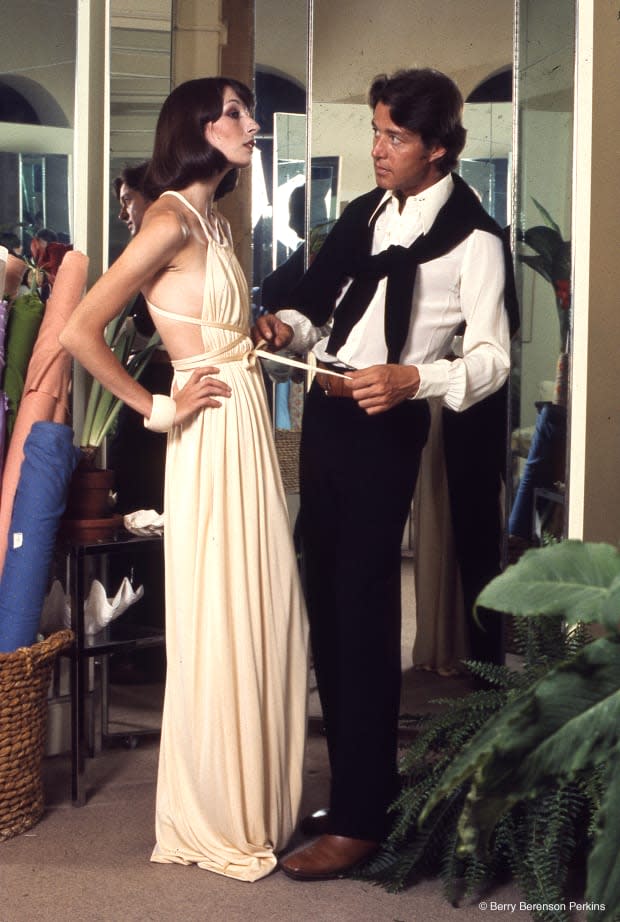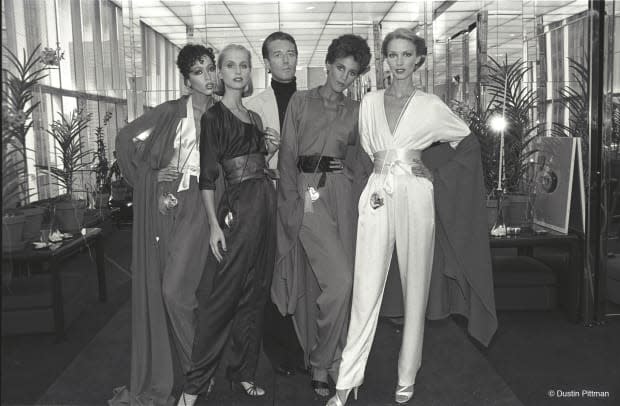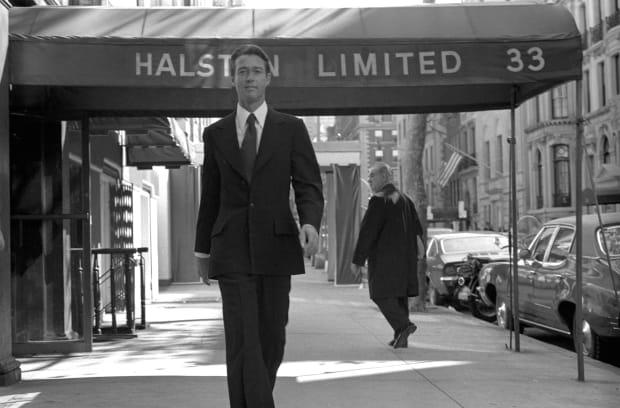'Halston' Shows How Glamour Was the Late Designer's Most-Applauded Strength — and His Biggest Weakness
The documentary, directed by Frédéric Tcheng and narrated by Tavi Gevinson, arrives in theaters on Friday, May 24.

When most of us picture '70s fashion, we think of Diane von Furstenberg's colorful, figure-flattering wrap dresses or Yves Saint Laurent's gender-bending Le Smoking tuxedos. However, many people have forgotten about Halston, who created some of the major garments that defined the decade — think the bias-cut satin dresses that elegantly skimmed the body.
Director Frédéric Tcheng and producer Roland Ballester seek to resurrect Halston's work and unveil his influential persona in their documentary "Halston," which will hit theaters on Friday, May 24.
Tcheng, who directed the well-received 2015 documentary "Dior & I," was hesitant when Ballester came to him with the idea to tell Halston's story. This is mostly because Tcheng, who's from France and was born after Halston's heyday, wasn't familiar with the designer. But Ballester is friends Halston's nephew, George Frowick, who connected him to his sister (and Halston's niece) Lesley Frowick. She lived and worked with Halston, and received his entire archive. In other words, she had all of the tools to tell her late uncle's story. Tcheng quickly became fascinated, and with "Halston," he aimed to tell it in an unconventional way.
Related Articles
'The Gospel According to André" Makes André Leon Talley the Star of His American Success Story
Vivienne Westwood May Hate the Documentary About Her, But Audiences Won't
'McQueen' Documentary Introduces Fashion's Beloved Genius to a New Generation
"The structure felt like an investigation," says Tcheng. "I didn't want it to be linear."
The film navigates through Halston's life in a series of archived clips intertwined with present-day interviews with models, celebrities, journalists and former co-workers. Lesley and the 23-year-old fashion blogger-turned-entrepreneur and actor Tavi Gevinson serve as recurring narrators. According to Tcheng, Gevinson was a natural fit for the film.
"I wanted someone who was curious, slightly nerdy and also had one foot in the fashion world and one foot in culture," says Tcheng, referring to Gevinson. "She talks about fashion from a very large point of view."
"Halston" starts as Gevinson, wearing her signature quirky glasses, sifts through tapes of Halston's archives, popping them into a VCR. Gevinson's appearances are sprinkled throughout the film and her presence is an unexpected, yet fitting twist.

The first clip is an old video of the designer, born Roy Halston Frowick, sporting a dapper suit and a smoldering look on his face. The Halston persona towards the public was glamorous and big on appearances, from the people he dressed to the people with whom he associated himself. Looks were a definite factor. The film details Halston's beginnings as head milliner at Bergdorf Goodman, followed by his transition to women's wear in 1969. Next, we witness Halston's glitzy party lifestyle at Studio 54 with Liza Minelli and Andy Warhol, as well as appearances with the "Halstonettes," a name given to models like Pat Cleveland and Karen Bjornsen who wore the designer's stylish silk gowns and took press trips for the brand.
Journalist Bob Colacello says, "He was drawn to people who displayed their emotions and also had this tremendous aesthetic side."
It's clear that Halston keeps his social life pack with celebrities and his work life full of creative projects. When the company is bought by consumer goods giant Norton Simon Industries in 1973, Halston expands his portfolio to design car interiors, home goods and perfume. He insists on having creative control over every project, which is where the film — and his career take a turn.
The unglamorous story of Halston's diminished reputation unravels. First, there is a collaboration with J.C. Penney in the '80s, which causes Halston to lose ties with Bergdorf Goodman. Next to come is the lavish spending, most of which went toward flower arrangements for the office, expensive press trips and decadent meals. Company President Carl Epstein warns Halston that the brand is in financial trouble, but the designer refuses to address the issue. He continues to overspend, parties nonstop and arrives to work late to avoid meetings with Epstein.

Along with other brand employees, Epstein decides to take legal action and force Halston out of the company. They win the lawsuit, portraying Halston as an unfit boss. Beginning in 1983, Halston can no longer design under his name and goes on to live the rest of his life in isolation. Several years later, in 1990, he dies of AIDS — an illness he hid from friends, employees and family for years.
The film showcases the ups and downs of Halston's life from the perspective of his closest friends and loved ones. His fearlessness towards being himself and pushing boundaries were exemplified in his work, and those closest to him truly respected his creative endeavors. It also really makes the viewer see that he was a pioneer during one of the most memorable eras of fashion: Halston started the designer-department-store collaboration and helped define '70s glamour.
While the film unveils the unfortunate decisions and occurrences that led to the diminishment of the Halston brand, viewers' opinions may shift about Halston, whether good or bad, because this is the first time his full life story is in the spotlight. "Hopefully history will be corrected a little bit," says Tcheng. "I really think he was one of the major names of the 21st century." The documentary develops its tasteful narrative through an artistic director and the help of a family member, which is likely how Halston would have wanted it.
"When he died there wasn't a great fortune," explains Tcheng, noting that despite public appearances, profit wasn't Halston's driving force. "He didn't do it for money. He did it for beauty."
Sign up for our daily newsletter and get the latest industry news in your inbox every day.